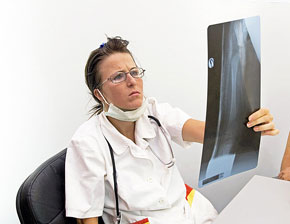Our brain and spinal column are the control center of our body. If these become damaged or altered, it can affect us in a variety of ways. With modern technology, our understanding of these effects is never-ending...
Common Neurological Diseases
Neurological diseases are abnormalities in the functioning of nervous system of the body that includes the brain, nerves and spinal cord. These could be structural, electrical or biochemical in nature and they could cause symptoms like muscle weakness, sensation losses, poor co-ordination, paralysis seizures, pain and confusion. Physiotherapy, neuro-rehabilitation, lifestyle changes, medication, surgery and pain management are the common types of interventions. In 2006, it was estimated by the WHO that around 1 billion people all over the world suffer from neurological diseases or subsequent conditions. Some of the common neurological diseases are as follows:
1. Huntington’s Disease:
This is one of the most common neurological diseases that has afflicted more than 30,000 people in America. Often referred to as Huntington’s Chorea, this disease is non-contagious and degenerative. Although it prolongs for over thirty years, it always ends in the death of the person. It is a genetic disease that has a 50% inheritance chance.
- The main symptoms include dementia, psychiatric disturbances (like mood swings, personality changes, OCDs) and movement disorders (like clumsiness, walking problems, stiffness).
- There is no cure for Huntington’s although some of the symptoms like psychiatric conditions and involuntary movements can be controlled with prescription drugs.
2. Parkinson’s Disease:
This is a disorder in the motor system and is both progressive and chronic. This is one of the most common neurological diseases affecting over one million people in America. It is neither genetic nor contagious.
- The main symptoms of Parkinson’s include limb stiffness, bradykinesia, balance impairment and tremors.
- The symptoms of secondary Parkinson’s include speech changes, sleep issues, constipation, chewing and swallowing problems and depression.
- Although there is no treatment to cure the disease, drugs have shown to provide a significant relief from several symptoms. Levadopa is the most common type of drug used to provide relief from bradykinesia and rigidity.
3. Epilepsy:
This is a non-contagious, chronic disorder that affects around 2.4 million people in the USA, with more than 125,000 cases developing every year. The main characteristic of this disorder is recurring seizures which are short electro-chemical disturbances in the brain that affect the normal functions of the body.
- The seizures could be generalized (those that occur throughout the brain) and partial (that affect only a portion of the brain). They are classified as simple partial seizures, complex partial seizures, absence seizures and tonic-clonic seizures.
- Like most of the common neurological diseases, there is no cure for epilepsy too. However, treatments like surgery and drug therapy and diet and sleep precautions can help in controlling seizures.
4. Alzhiemer’s Disease:
Alzhiemer’s, one of the most common neurological diseases, affects more than 4 million Americans. It is degenerative and causes behavioral changes and cognitive problems.
- The common symptoms include memory loss, time and space confusion, personality changes, mood swings and problems with understanding and abstract thinking.
- No cure for this disease has been discovered yet and even the options for treatment are limited. However, drugs such as donepezila and tacrine have proved to provide temporary improvement in the behavior and memory skills of patients and decreased the rate of progression of the disease.

- Home
- Acupuncture Therapy For Neurological Diseases
- Chronic Neurological Diseases
- Common Neurological Diseases
- Degenerative Neurological Diseases
- Equine Neurological Diseases
- Fatal Neurological Diseases
- Genetic Neurological Diseases
- Hereditary Neurological Diseases
- List Of Neurological Diseases
- Most Common Neurological Diseases
- Neuro-Infectious Diseases
- Neurological Autoimmune Diseases
- Neurological Degenerative Diseases
- Neurological Diseases In Children
- Neurological Diseases In Dogs
- Neurological Diseases In Horses
- Neurological Disorders Brain Diseases
- Neurological Genetic Diseases
- Neurological Symptoms
- Neurological System Disorders
- Pediatric Neurological Diseases
- Rare Neurological Diseases
- Symptoms Of Neurological Diseases
- Treatment Of Neurological Diseases
- Types Of Neurological Diseases
